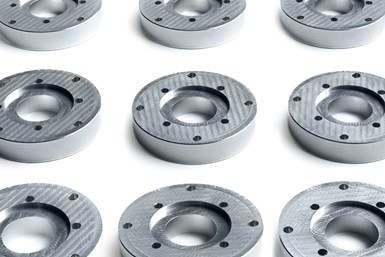Protolabs Expands CNC Capabilities, Accelerates Anodizing, Chrome Plating
Expanded CNC machining capabilities enable product developers and production buyers to obtain custom-plated parts in as fast as four days.

Photo Credit: Protolabs
Digital manufacturer Protolabs has expanded its CNC machining capabilities again to enable accelerated anodizing and chromate plating on aluminum components. From time of quote to manufacturing to shipping, the company says customers can get custom machined parts with plating in as fast as four days.
“While traditional finishing processes like anodizing have been around for a while, never have manufacturers been able to consistently produce parts as fast at scale as we have at Protolabs,” says Greg Thompson, global product director of Protolabs’ CNC machining. “An engineer can have fully anodized or plated parts on their desk within a few days of placing an order.”
Anodizing and plating help prevent corrosion, strengthen parts and improve cosmetic appearance. All plating options for machining are available to customers when they upload a 3D CAD model on the company’s website.
Eligible materials include aluminum 6061/6082 and 7075. For anodizing, three specific types are offered: Type II (Class 1, Class 2) and hard-coat Type III (Class 1); for chromate plating, Type II is available.
The addition of quick-turn plating builds on the digital manufacturer’s portfolio for CNC machining, which includes advanced anodizing and chromate plating capabilities with flexible lead times. Customers with AS9100 and ITAR needs can access Protolabs’ precision machining capabilities and those with more complex, high-requirement parts can tap into the company’s digital network of manufacturers at Hubs.
“We’ve promised our customers more capabilities across all our service lines this year, and our machining service is leading the way,” says Rob Bodor, Protolabs president and CEO. “Through our unique manufacturing model that pairs a network of global manufacturers with our digital factories, we can comprehensively serve the prototyping and production needs of our customers.”
Related Content
-
10 Anodizing Best Practices
Following this list of guidelines can help to increase the performance, cost effectiveness and quality for your anodizing operation.
-
A Smooth Transition from One Anodizing Process to Another
Knowing when to switch from chromic acid anodizing to thin film sulfuric acid anodizing is important. Learn about why the change should be considered and the challenges in doing so.
-
Pulling Out All the Stops
Evolving coatings and finishes for automotive brake components.















